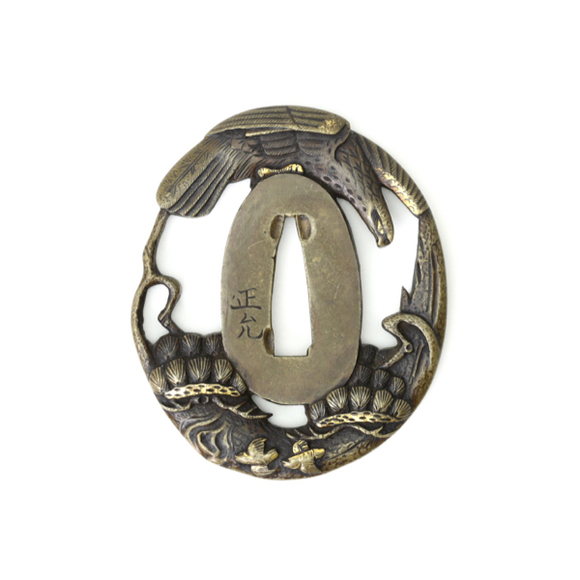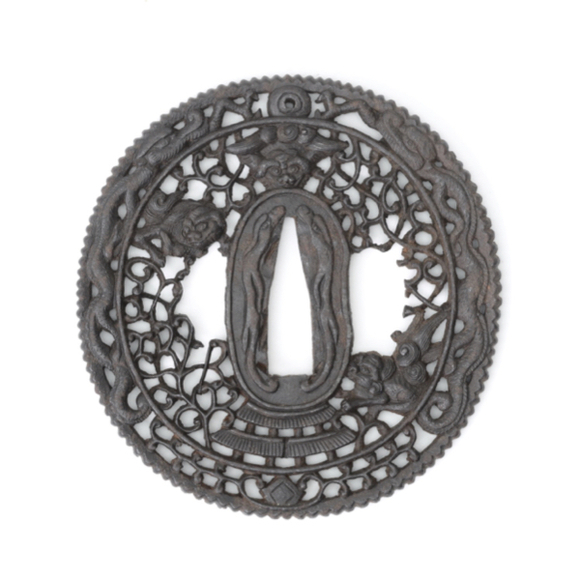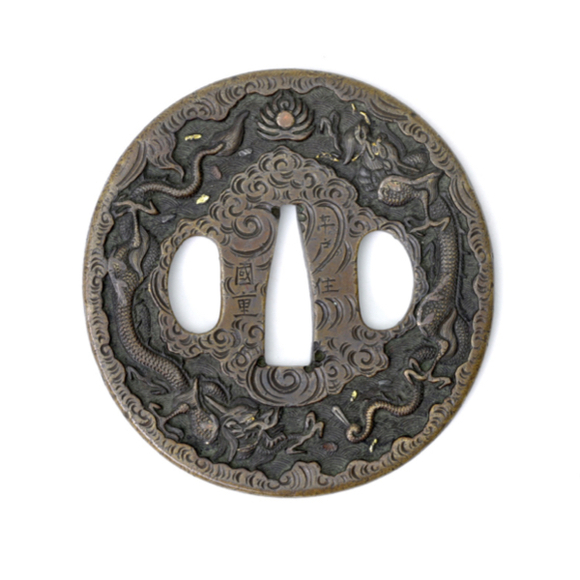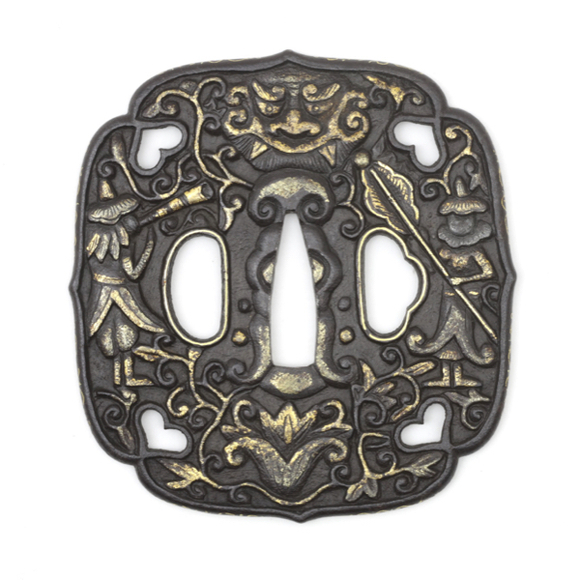Russet iron, one-piece construction with decorative grooves.

Sheathed 54.7 cm
Mace 52.8 cm
38.2 cm
Base 11.5 mm
Middle 9 mm
5 cm from tip 6 mm
Base 23 mm
Middle 15 mm
5 cm from tip 11 mm
539 grams
7 cm from guard
Iron, steel, wood, shibuichi, shakudō, silver, gold
Japan
Edo period
18th or 19th century
Peter Finer, London
Introduction
The hachiwari (鉢割; "skull splitter") or kabutowari (兜割; "helmet splitter") is a type of Japanese sword-catching mace that some samurai carried. Typical examples have a slightly curved rod and a cook on the hollow side to catch a blade. Some have sharp points, others are blunt, like this one. They are very rare on the market, and no school of using them has survived until today.
I prefer the less common name hachiwari because these weapons are unlikely to split a helmet but would do damage on unarmored opponents. The name kabutowari may have been derived from a misinterpretation of hachiwari where hachi can mean both skull or helmet.1
Functionally it may have been replaced by the jitte, a somewhat similar Japanese sword catching-mace that tends to have a straight blade and a larger catching hook. These were carried by imperial police, palace guards, and some samurai.
Notes
1. Markus Sesko; Encyclopedia of Japanese swords. Lulu Enterprises, Inc. 2014. Page 158.
This example
This is the first example of a hachiwari we have on this site, and a very fine one at that.
The substantial rod has a flat back and rounded "edge", tapering gently towards a blunt point. At the base is a hook, nicely made with a faceted back, mimicking the geometry of a Japanese spearhead and its base.

Markings
Both sides of the rod are inscribed with kanji.

摹楠判官正成公之傅而
Mo Kusunoki Hōgan Masashige kō no denji
“Modelled after the [object worn by] Kusunoki Hōgan Masashige.”
文林亭妿杄作之
Bunrin Teikasen kore o tsukuru
“Made by the literary companion Teikasen.”
(Translated by Markus Sesko.)
Kusunoki Masashige (1294-1336 A.D.) was an exemplary samurai of the Kamakura period who fought for emperor Go-Daigo. He became an icon of bravery, loyalty, and devotion to the emperor. He supposedly wore a hachiwari which was published in the Shuko Jisshu (集古十種) or "Ten ancient collections" of 1800. This project was lead by Sadanobu Matsudaira, a daimyo and senior counsel to the Shogun. His team traveled around the country to document antiquities in various collections, including temples and shrines.

The Hachiwari of Masashige as illustrated in the Shuko Jisshu.
It was signed as having been made by no less than Gorō Nyūdō Masamune.
Hilt
The hilt is made of iron, with darkened copper alloy mounts. The style reminds of old tachi styles of the Kamakura period. It has a small oval disc guard. On either side of the hilt is a menuki made of shakudō depicting a bird and millet, traditionally a reference to autumn and a popular motif among painters of the Muromachi period.1

Scabbard
It comes with a fine black laquered scabbard with flakes of mother of pearl, fitted with mounts in soft metals including a silver chape.
Comparable examples
A very nice one with rather similar blade and hilt design was sold at Christies in 2017. Arts of the Samurai; The Dolphyn Collection, lot 89. It was signed "Banzai Saku", or "Made by Banzai". No wordsmith by this name is known to me.
Condition
Excellent condition. Only some very minor damage to lacquer, and signs of some skilful restorations to the lacquer.
Conclusion
A very fine example of a hachiwari, complete with high-quality lacquered scabbard. During the Edo period, Kusunoki Masashige -who is referred to on the inscription on the rod- was seen as an icon of devotion to the emperor. Besides being a practical sword catcher, the piece was probably also worn as a status symbol and means of showcasing loyalty and allegiance to the emperor.
A very rare piece, in excellent condition.
Notes
1. See a painting with millet and sparrows in the Metropolitan Museum, accession number: 1975.268.40.






















Unusual tsuba with foreign figures and Chinese auspicious symbols.






